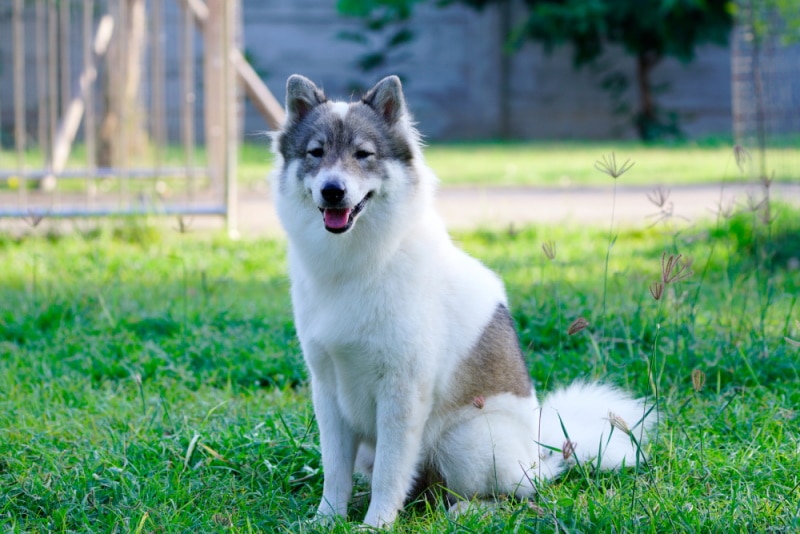English vs American Mastiff: The Differences (With Pictures)
Updated on
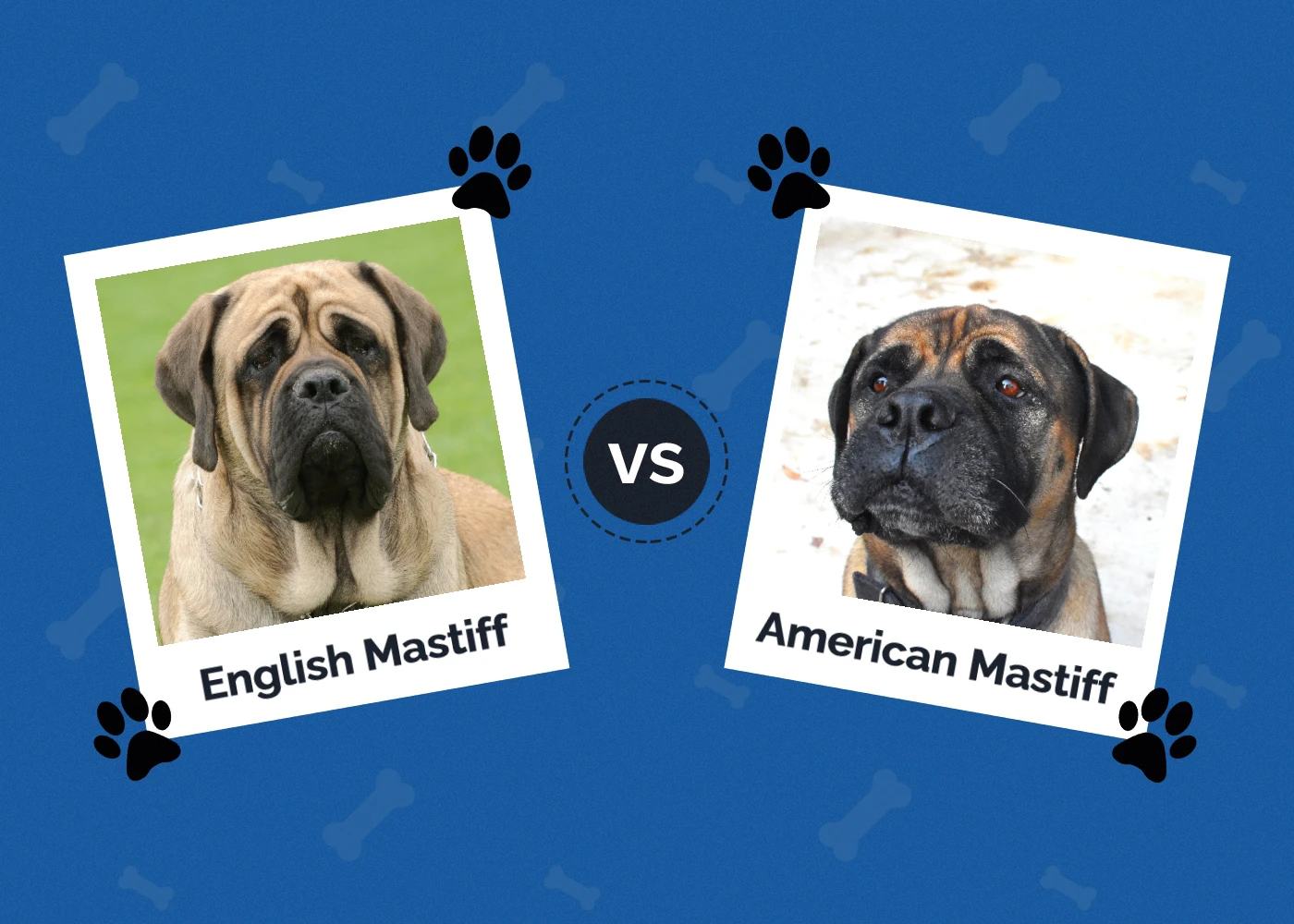
Do you love big, bold, powerful dogs? If yes, the American Mastiff and the English Mastiff are undoubtedly on your list of possible dogs to adopt. Both breeds are massive canines that can weigh 200 pounds or more and are incredibly powerful. Luckily, American and English Mastiffs are affectionate dogs when socialized well and are especially good with children. If you want to learn the differences and similarities between these two large breed dogs, read on. We have all the details for you below!
Visual Differences
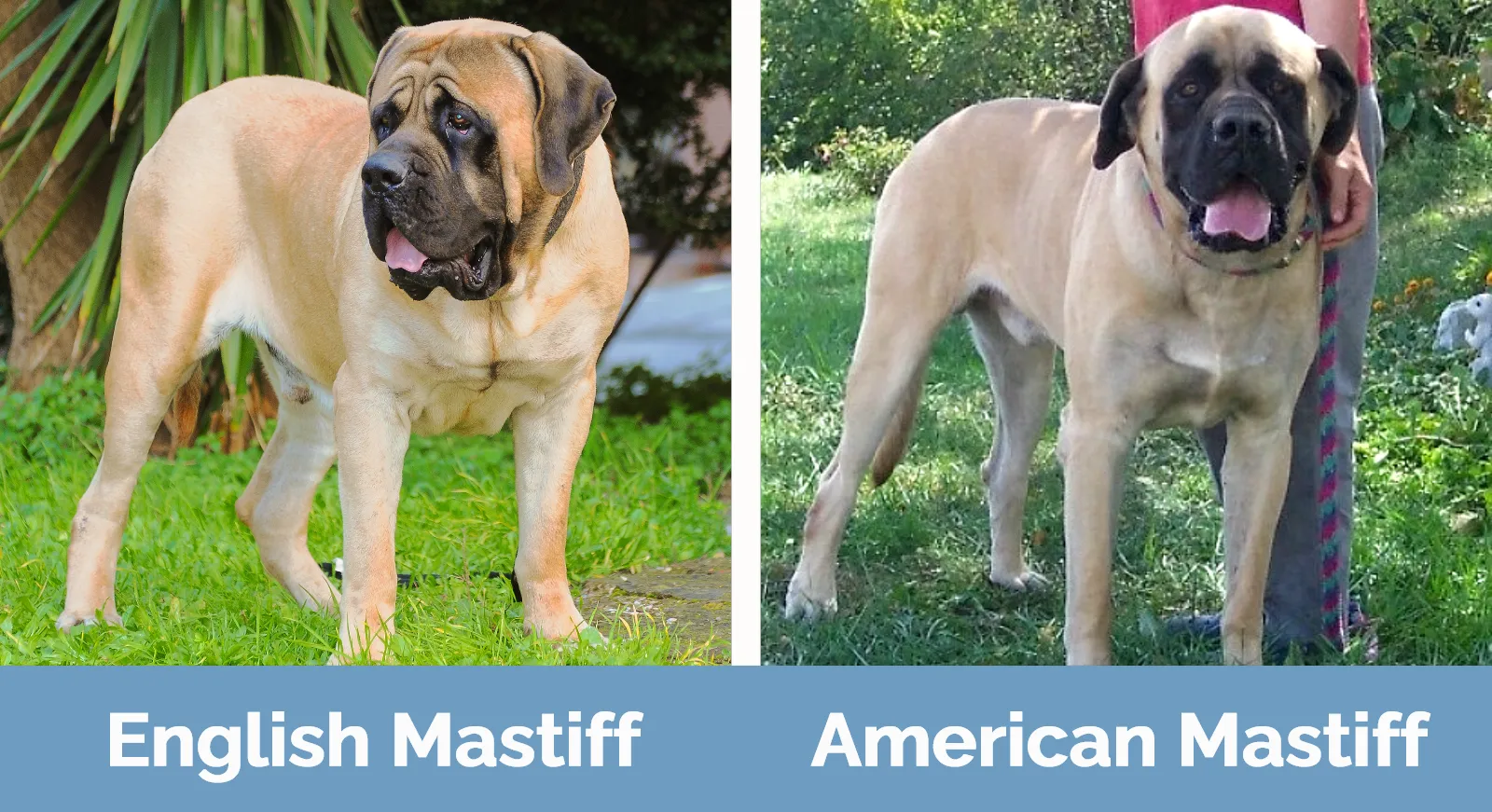
At a Glance
- Average height (adult): 27–30 inches
- Average weight (adult): 120–200 pounds
- Lifespan: 6–10 years
- Exercise: 1+ hours a day
- Grooming needs: Low
- Family-friendly: Yes
- Other pet-friendly: Yes
- Trainability: Somewhat stubborn, sensitive
- Average height (adult): 27–30 inches
- Average weight (adult): 120–200 pounds
- Lifespan: 6–10 years
- Exercise: 1+ hours a day
- Grooming needs: Low
- Family-friendly: Yes
- Other pet-friendly: Yes
- Trainability: Less stubborn, cooperative, sensitive
English Mastiff Overview
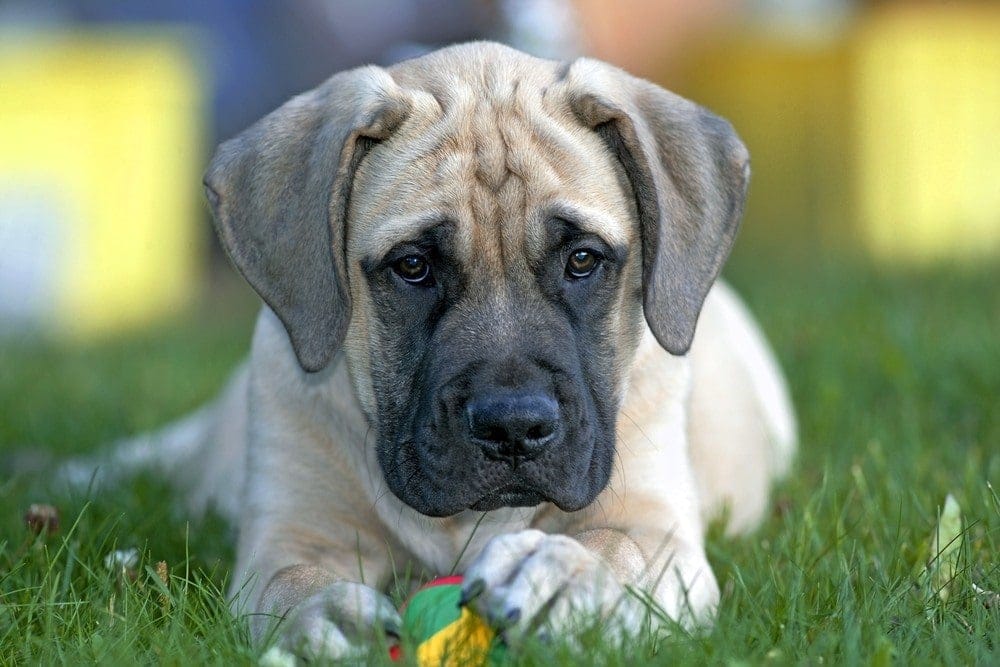
Personality / Character
The English Mastiff has a very stoic character that belies their patience, affection, and gentleness. English Mastiffs are the epitome of loyal dogs and highly protective of their family members. However, English Mastiffs can be wary and slightly aggressive with strangers, which makes their socialization essential. They are alert dogs, to be sure, and make excellent guard dogs.
Training
It’s long been known that English Mastiffs are highly intelligent and sensitive dogs that also have a definitive stubborn streak. This makes them slightly difficult to train, especially if you yell or get mad at your dog. The sensitive dog doesn’t tolerate being yelled at, and they will retreat to a safe space until you calm down.
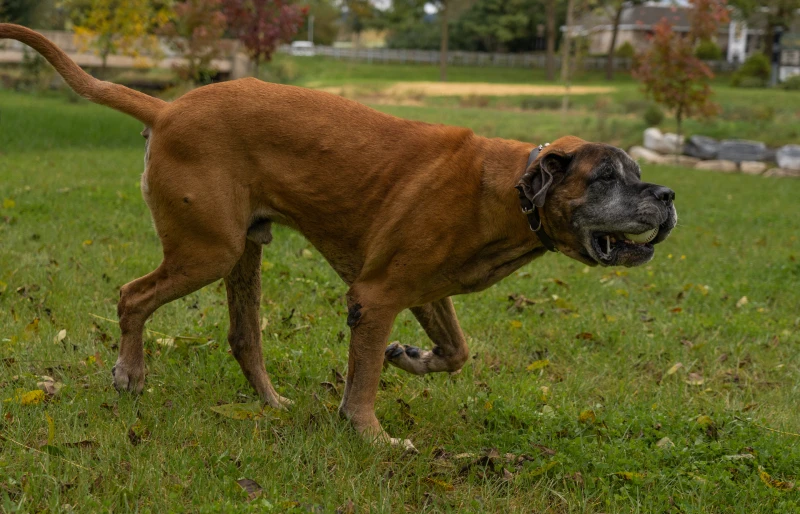
Health Issues
English Mastiffs suffer from a variety of health issues due to their large size. One of the worst is hip dysplasia, a common health issue among large breeds. Unfortunately, that’s not all, as the list below will attest.
- Seasonal allergies
- Eye anomalies
- Heart disease
- Cancer
- Von Willebrand’s disease
- Degenerative myelopathy
- Epilepsy
- Hygromas
- Bloat
Social Skills
It’s imperative that you socialize your English Mastiff well when it’s a puppy. That way, when it becomes a giant adult dog, your English Mastiff will be gentle, affectionate, and much less aggressive toward strangers. If you do the job well, you’ll end up with a big baby of a giant dog that loves spending time with you and your family and gets along well with most people. Unless they grow up together, getting an English Mastiff to tolerate other canines is difficult.
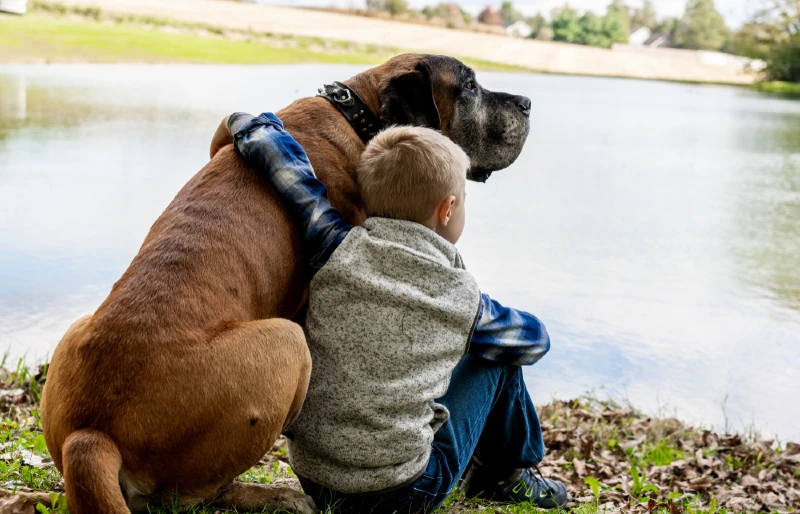
Grooming Requirements
As big as they are, English Mastiffs don’t require a lot of daily or even weekly grooming. They have a short, double coat that’s easy to brush and doesn’t shed too much. Brushing yours once or twice a week should be plenty. As big as they are, you might want to consider a professional groomer to care for your pet’s grooming needs, which they won’t need often. One thing these dogs do, however, is drool a lot. That means having a small towel handy is essential to clean up after them.
Suitable for:
Adopting an English Mastiff must be done with care, as owning a massive dog like this takes a lot of time, energy, and patience (as well as money). An English Mastiff also needs a large amount of space, so they might not be a good choice for owners who live in apartments. English Mastiffs are great with children and make top-notch guard dogs and protectors. For seniors, they aren’t a great fit as they’re too big and powerful.
- English Mastiffs are gentle and calm dogs
- They are very protective and loyal
- Grooming needs are minimal
- They shed moderately for a big dog
- Exercise needs are low to moderate
- They bark very little
- Have a tendency to become lazy
- They drool a lot
- Can be incredibly destructive if not trained well
- Can be aggressive with strangers
- The right food for a Mastiff can cost a lot
American Mastiff Overview

Personality / Character
Like the English Mastiff, the American Mastiff, when well-socialized as a puppy, can be an affectionate dog. The breed is also intensely loyal and will guard its family with its life. At the other end of the spectrum, don’t be surprised if your American Mastiff tries to be your lap dog (even though it’s much bigger than any lap). The American Mastiff is hesitant around strangers, but as soon as trust is established, they can be quite friendly.
Training
The American Mastiff is almost identical to the English regarding training. They’re stubborn and sensitive and demand an owner who won’t back down but is authoritative and highly consistent. The American mastiff also tends to daydream, so keeping training sessions short and sweet is recommended lest they ignore you.

Health Issues
American Mastiffs suffer from the same health and genetic issues as their English counterparts because of their massive size. Those issues include:
- Hip and elbow dysplasia
- Eye anomalies
- Arthritis
- Congestive heart failure
- Glaucoma
- Cataracts
- Progressive Retinal Atrophy (PRA)
- Epilepsy
- Hygromas
- Bloat
Social Skills
Socializing your American Mastiff is a critical step in its development that will lower your dog’s innate protective nature and aggression. When done well, most American Mastiffs, like their English counterparts, will become good-natured adults full of affection and love for you and your other family members. They’ve even been known to get along well with cats as long as they grow up together.

Grooming Requirements
You’ll be glad to know that, as with the English Mastiff, the American Mastiff needs very little in the way of daily grooming. They shed, but not much, and brushing your dog twice a week should keep the fur from flying all over your home. However, American Mastiffs frequently drool but much less than their English cousins.
Suitable for:
Like the English Mastiff, the American Mastiff demands a lot of your time, energy, and just as much money in terms of food, toys, healthcare, etc. They get along beautifully with children, although if you have kids, training them to engage with your American Mastiff correctly is a good idea. Big families with big homes and yards are the best for American Mastiffs, as they need a lot of space. You should also be a gentle but firm trainer who trains with positive reinforcement since American mastiffs are surprisingly sensitive dogs.
- Large, powerful, protective dogs
- Affectionate if socialized well
- Don’t shed too much
- Have minimal daily grooming needs
- Bark infrequently
- Don’t need much exercise to be happy
- Aren’t long-lived dogs
- Can be possessive and aggressive if not socialized well
- Their food can be expensive
- They suffer from several health issues
- Need a lot of space
English Mastiff vs American Mastiff: Barking
You’ll be pleased to know that the American and English Mastiffs bark very little. That’s normal for giant breeds, and you can expect your Mastiff to bark only when they have a very good reason to bark. Some Mastiffs will suffer from separation anxiety, which could cause them to bark more. However, English and American Mastiffs don’t often suffer from separation anxiety.
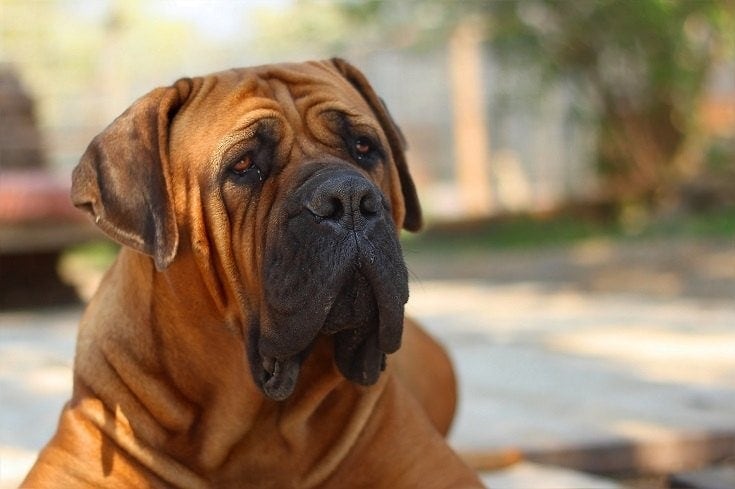
English Mastiff vs American Mastiff: Drooling
We noted earlier that the English Mastiff drools quite a bit. On the other hand, the American Mastiff drools much less, which is why many people who want to adopt a mastiff breed choose the American over the English Mastiff. The American Mastiff is a better choice if you’re not a big fan of dogs that slobber.
Which Breed Is Right for You?
There are very few major differences between the American Mastiff and the English Mastiff. Both are gigantic, powerful, stoic dogs who can grow larger and taller than the average man. They’re gentle and affectionate dogs if well socialized, which is critical to reducing their territorial and aggressive nature.
These Mastiff breeds need a big space to live, get along swimmingly with kids, and make excellent watchdogs and protectors. Unfortunately, they both live short lives, and most Mastiffs won’t make it past 10 years old. That’s a shame because, once socialized and calm as adults, American and English Mastiffs make wonderful pets and loyal companions. Either would be a great pet, with the single caveat that American Mastiffs drool much less than their English counterparts.
Related Reads:
- French Mastiff vs. English Mastiff: The Key Differences (With Pictures)
- English vs. Neapolitan Mastiff: The Key Differences (With Pictures)
Featured Image Credit to: Left – English Mastiff (Waldemar Dabrowski, Shutterstock) | Right – American Mastiff (PJW31189, Shutterstock)




